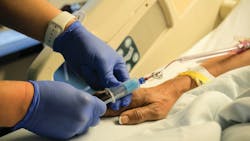In the late 1990s, an industry-wide trend to decentralize phlebotomists was well underway, and the future of the profession was in doubt. Today, phlebotomists are not only reclaiming their status as laboratory professionals, but their roles are expanding to include functions previously delegated exclusively to nurses.
Instead of diminishing phlebotomy as a procedure any healthcare professional can perform with minimal or no training, administrators are learning it’s not as easy as a good phlebotomist makes it look. With plunging patient satisfaction scores and sample quality hitting rock bottom, many decentralized systems have walked it back, returning blood collection procedures to laboratory personnel who are sample-centric by nature and perfectly suited to maintain the quality of the samples they test.1
With renewed recognition for their skill, the once- marginalized phlebotomist is today’s venous-access specialist who not only performs venipunctures and skin punctures but draws blood from vascular access devices (VADs) unassisted. In some states and hospitals, phlebotomists have even been trained to start and discontinue IVs.
Such a significant practice change for both nursing and phlebotomy professions requires solid training and strong coordination with nursing. Facilitating the transition, new technologies are emerging that utilize a phlebotomist’s skill set while significantly reducing pre-analytic errors when drawing from a VAD.2
Advanced phlebotomy teams
The Mayo Clinic has been an early leader in applying phlebotomy’s strengths to other practices. Sharon Johnson manages Mayo’s Vascular Access Technician (VAT) team where select phlebotomists are taught IV access procedures for the facility’s intensive care units. Johnson found that the skill set required for venipuncture was highly transferable to IV access and could even increase first-attempt success rates.
“Our cardiac team wanted faster laboratory turnaround times (TATs), better patient care, improved customer service, and fewer rejected samples,” says Johnson, the Operations Manager in the Division of Clinical Core Laboratory Services at Mayo Medical Laboratories. “One of our top priorities in this practice change is to choose individuals who want to expand their skills and have proven themselves to be dedicated and experienced phlebotomists.”
Johnson plays a critical role in staffing the IV access team with qualified phlebotomists. She admits the success of the program would have been uncertain without an aggressive approach to the practice change at Mayo. While improving sample quality from line draws remains at the heart of the cross-training initiative, she gives a high priority to making sure they receive intensive training which includes 30 additional hours of training, and shadowing with nursing to ensure proper IV placement and dressing.
“You can’t abbreviate the training for such a major practice change,” says Johnson. You have to teach more than how to draw off of IVs independently, but teach them the ‘why’ of each step and the consequences of not performing it properly. Only when you train meticulously can you realize the full benefit of faster lab TATs and fewer rejected samples. Our vascular access techs have to familiarize themselves with the materials and perform 20 successful IV starts under supervision before being cleared.”
At Mayo, the commitment of laboratory management to taking the lead in the cross-training initiative has paid off in a multitude of benefits for all involved.
“This practice change continues to deliver better patient care and customer service, faster TATs, higher quality samples, and staff satisfaction,” she says.
Obstacles removed
Historically, one of the biggest arguments against involving phlebotomists in drawing from IV lines has always been the nature of VADs to hemolyze and dilute samples. Studies show samples drawn during an IV start or from an existing line have the potential to be hemolyzed up to 78 percent of the time depending on the size and composition of the cannula, the force of the withdrawal, and other factors.3-5 Very few VADs are engineered to be red-cell friendly. Another study showed draws from temporarily discontinued IVs to be contaminated with fluids, even after two minutes.6
However, with the introduction of devices designed for drawing from IV lines that reduce the risk of hemolysis and IV contamination, the biggest arguments against drawing from VADs have been neutralized.
One device specifically designed to draw blood from peripheral lines attaches to the luer adapter of the VAD. If necessary, a nurse may pause infusing fluids and flush the line. Then the phlebotomist or nurse advances a flexible tubing engineered for blood collection through the line, beyond the catheter tip and into the vein. The user then aspirates the blood sample with a syringe or evacuated tube system. Following a blood collection, the nurse may restart fluids as necessary.
One healthcare system implementing this line-draw technology is Intermountain Healthcare in Utah. By training phlebotomists and nurses to draw from lines throughout their dwell with devices engineered to improve sample quality, a retrospective analysis showed they were able to reduce hemolysis 39 percent. With a success rate for drawing from VADs up to 95 percent, Intermountain has reduced the number of venipunctures performed by up to 50 percent system-wide.
Much like the Mayo Clinic, Intermountain engages their phlebotomists in intensive training prior to allowing line draws. The training begins with a one-hour classroom review of the required technology, venous anatomy, and peripheral IV functions. A thorough review of roles and responsibilities ensures that nurses remain solely responsible for assessing IV catheters and pausing infusions.
An adaptable skill set
Teaching phlebotomists to become part of an IV access team is not as difficult as some may think. Many of the necessary skills are already in place such as preparing the site, locating veins, anchoring, inserting the needle, troubleshooting needle placement, and more. Since phlebotomists performing venipunctures are skilled at advancing needles into veins and withdrawing blood via a tube holder assembly or syringe, there is a familiarity with technique that makes their cross-training a natural extension of an existing skill set. In addition, they bring their vast knowledge of preanalytic error prevention to the table.
“Phlebotomists are well-suited to be given IV-access responsibilities because of their initial training and having mastered vascular accessing via venipuncture,” says Johnson. “But what’s key to their success is their understanding of all the preanalytical variables associated with blood collection.”
Patients with difficult veins are the most obvious benefactors of devices that draw successfully from existing or newly inserted lines. With the first-stick failure rates for venipunctures being as high as 20 percent for some groups, obtaining high-quality samples from an established point of access not only expedites the process, but reduces frustration on both sides of the encounter.
The University Hospitals of Cleveland’s Medical Center (UHCMC) has also implemented technology to draw blood from VADs. UHCMC has conducted over 40,000 successful draws from lines reducing the number of venipunctures performed by 30 percent or more.
“Establishing effective coordination and partnerships between nursing and phlebotomy staff has been essential to the successful implementation of VADs for routine inpatient blood draws in our institution” says Jaime Noguez, PhD, DABCC, UHCMC’s Director of Chemistry and Toxicology. “Raising awareness of the unique skills and needs of each member of the patient management team facilitated the development of sustainable workflows as well as an improvement in the patient experience regarding laboratory testing.”
The regulatory myth
Though many think there are regulations against phlebotomists touching IVs, it’s more myth than reality.
“The FDA considers a prefilled syringe for saline flushes as a device, not a medication,” says Christopher Bland, PharmD, FCCP, FIDSA, BCPS, a Clinical Associate Professor at the University of Georgia College of Pharmacy. “The Joint Commission and the pharmaceutical industry at large agree. So, there’s no need for that misconception to prevent managers from giving phlebotomists more vascular-access responsibilities with proper training except in those few states that impose other restrictions.”
While it’s true phlebotomists cannot decide if an IV is necessary or assess an existing IV, regulations in three quarters of the United States either expressly allow or do not restrict unlicensed assistive personnel from inserting a VAD or flushing it with pre-filled saline if properly trained and delegated by a nurse.
Conclusion
A more holistic view of phlebotomists’ skills clearly shows phlebotomy professionals can be better utilized as venous-access specialists when they are given proper support from leadership, coordination with nursing, and the requisite education and training. Having expertise in reducing preanalytical errors, no professional is better suited to collect high quality blood samples by any method or with any device, including line draws.
As the role of the phlebotomists breaks new ground and the necessity of a partnership with nursing becomes more obvious, the real winners of this practice change are the patients. By cutting the number of venipunctures in half or greater, patient satisfaction scores can rise to new levels in facilities bold enough to change the way they draw blood specimens.

